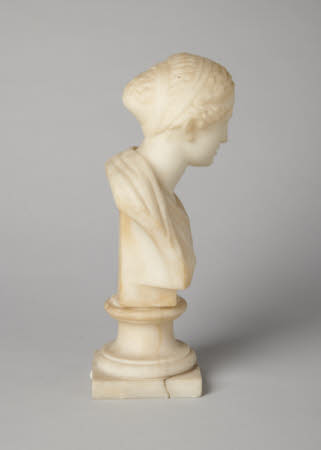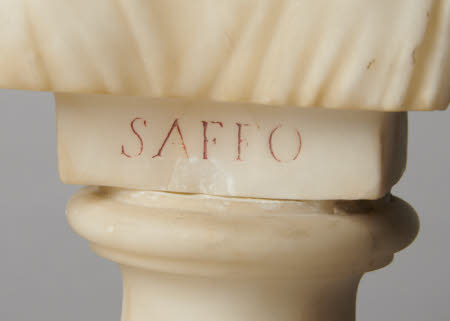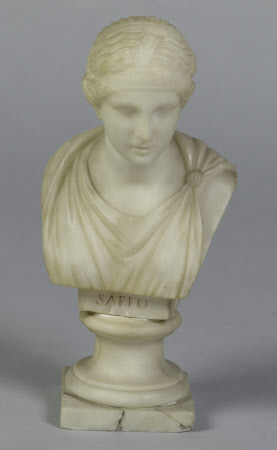Portrait of the lyric poet Sappho
Roy Coles
Category
Art / Sculpture
Date
c. 1840 - 1900
Materials
Alabaster
Measurements
274 x 140 x 127 mm
Place of origin
Italy
Order this imageCollection
Mount Stewart, County Down
NT 1220130
Summary
Sculpture, alabaster; portrait bust of Sappho (born c. 650-600 B.C.); Italian; c. 1840-1900. A small portrait of the ancient Greek lyric poet Sappho, much of whose poetry dealt with love between women or girls. This sculpture was given to Edith, Marchioness of Londonderry by the celebrated London hostess Emerald, Lady Cunard.
Full description
A small portrait in alabaster of the Greek lyric poet Sappho (born c. 650-600 B.C.), depicting the subject in the form of a herm, her head tilted slightly to her left and downwards. She wears a chiton dress fastened at the left shoulder with a brooch. Her hair is fastened by means of an opisthosphendone, a type of ancient Greek headband that here crosses her forehead, with another band over the top of her head connecting with a circular band at the back. The inscription ‘SAFFO’ on the front of an integral rectangular block below the bust section. A separately carved waisted socle, on a rectangular base. The base is broken at the front and repaired. Sappho was a Greek lyric poet who seems to have lived mainly on the island of Lesbos and was born some time during the second half of the seventh century B.C. Almost nothing is known about her life, except that she may have spent a period of exile in Sicily. It is thought that she was probably married and that she had a daughter, called Cleis. With the exception of two complete poems, Sappho’s poetry survives only in fragments, but it is known to have been collected into eight or nine books. Many of her poems refer to love between women or girls, so that in modern times she has come to be seen as an important representative figure for same sex relationships, with the word ‘sapphic’ derived from her name and ‘lesbian’ from the place of her birth. The little head seems to be loosely derived from a marble head on a modern bust in the Uffizi, Florence (Inv. 369; Mansuelli 1958-61, I, no. 11), which is sometimes identified as Sappho, although it is more generally thought to be a portrait of Aphrodite, the goddess of love. It is quite probable that it was made in the alabaster carving workshops in Volterra, not far from Florence. The Sappho is first recorded in the Yellow Drawing Room of Londonderry House in London, in an inventory drawn up in 1939, in which it was recorded that it had been given to Edith, Marchioness of Londonderry by the socialite Emerald, Lady Cunard (1872-1948), at whose house the Londonderrys frequently dined when in London. Jeremy Warren August 2022
Provenance
Emerald, Lady Cunard (1872-1948); before 1939, given by her to Edith, Marchioness of Londonderry (1878-1959); Yellow Drawing Room, Londonderry House, 1939; Lady Mairi Bury (1921-2009); lent to the National Trust in 1976; accepted by HM Government in lieu of Inheritance Tax and allocated to the National Trust in 2013.
Marks and inscriptions
Front, tablet below bust:: SAFFO
Makers and roles
Roy Coles, sculptor
References
Londonderry House 1939: A Catalogue and Valued Inventory of the Furniture and Works of Art at Londonderry House, Park Lane, W... Prepared for the purposes of insurance, with historical notes, by H. Clifford-Smith, 1939, p. 68. Mansuelli 1958-61: Guido Mansuelli, Galleria degli Uffizi. Le sculture, 2 vols., Rome 1958-61, I, pp. 37-38, no. 11.







